深入理解计算机系统 Lab2 bomblab
datalab https://www.cnblogs.com/vv123/p/17154464.html
简介
CS:APP3e, Bryant and O'Hallaron (cmu.edu)
bomblab是CS:APP第三章 程序的机器级表示配套实验。该实验有6个关卡,要求学生对一个 Linux/x86-64 binary bomb 进行逆向分析,获取正确的6个字符串,以拆除炸弹。
A "binary bomb" is a program provided to students as an object code file.
When run, it prompts the user to type in 6 different strings. If any of these is incorrect, the bomb "explodes," printing an error message and logging the event on a grading server.
Students must "defuse" their own unique bomb by disassembling and reverse engineering the program to determine what the 6 strings should be.
The lab teaches students to understand assembly language, and also forces them to learn how to use a debugger. It's also great fun.
将 bomb.tar 解压后,只有三个文件。

bomb 是一个可执行二进制文件, bomb.c 是它的源文件,但包含的头文件并未给出,因而无法直接编译。
执行 ./bomb 后,需要依次输入6个字符串,如果输入错误就会“引爆炸弹”。

前置知识:C语言,gdb,CSAPP前三章。
个人环境:wsl2(ubuntu 20.04), 用vscode ssh连接,直接看反汇编即可。
常用的东西:
GDB命令
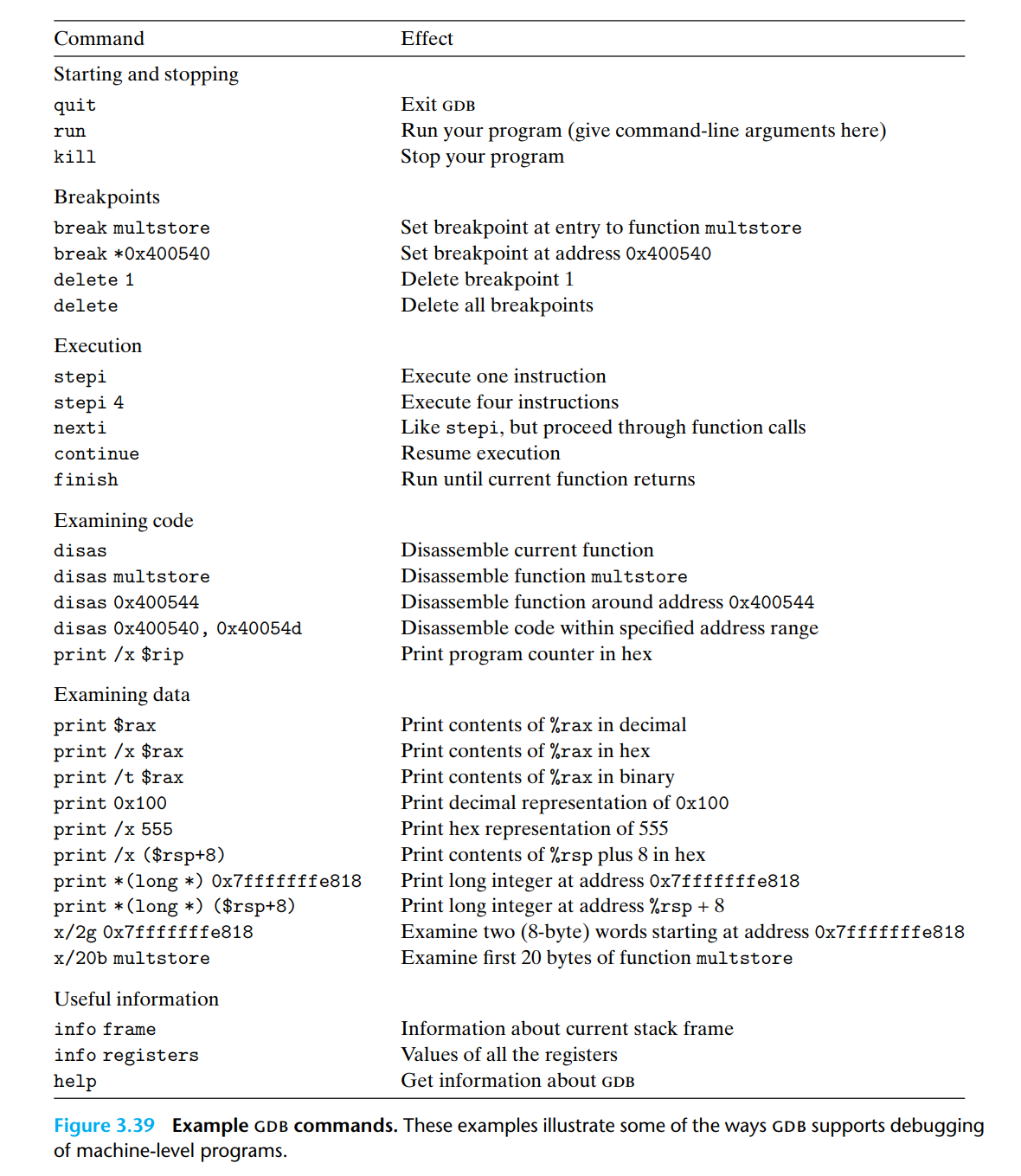
x86_64寄存器表
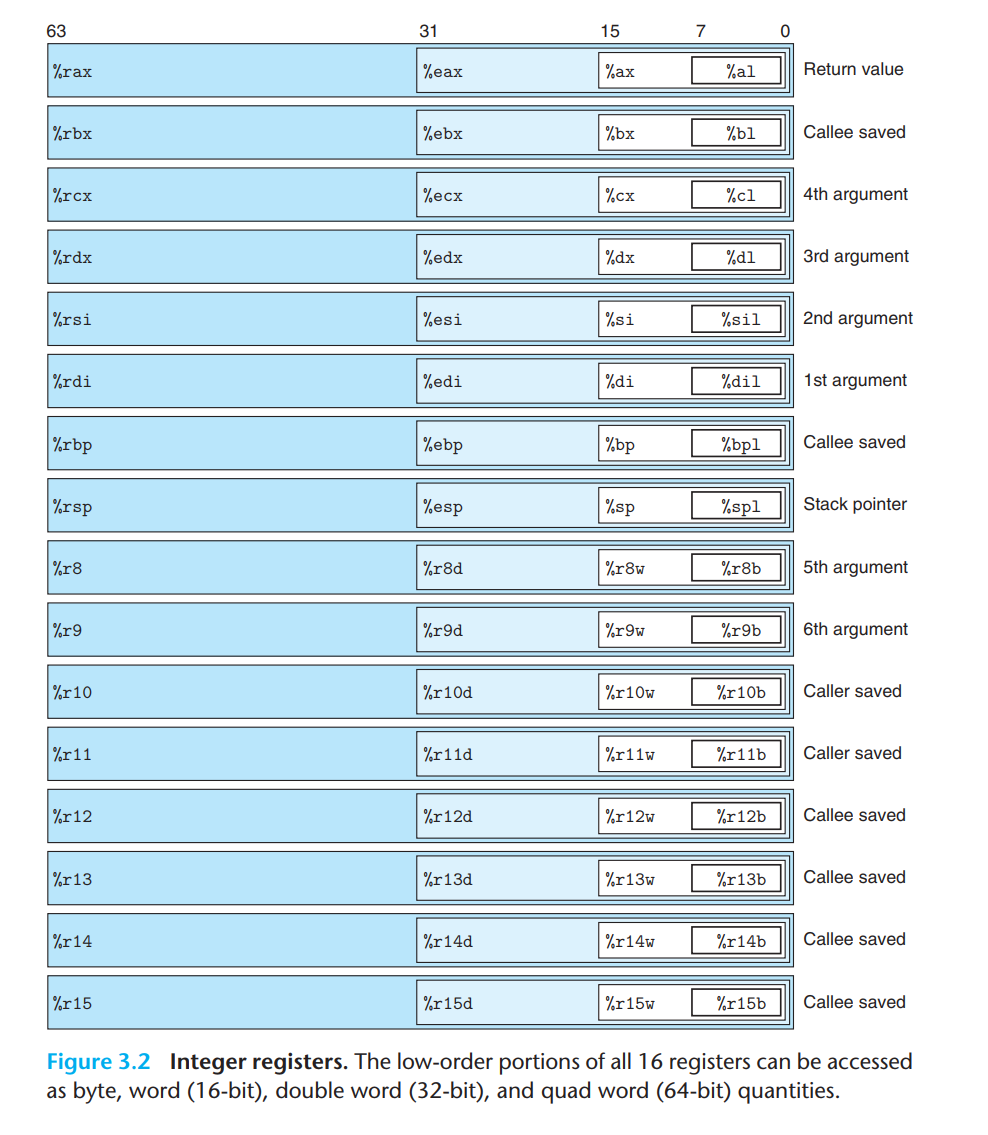
Parse 1 字符串比较
让我们先来看看 bomb.c ,它非常短,几乎得不到什么有用的信息。
/***************************************************************************
* Dr. Evil's Insidious Bomb, Version 1.1
* Copyright 2011, Dr. Evil Incorporated. All rights reserved.
*
* LICENSE:
*
* Dr. Evil Incorporated (the PERPETRATOR) hereby grants you (the
* VICTIM) explicit permission to use this bomb (the BOMB). This is a
* time limited license, which expires on the death of the VICTIM.
* The PERPETRATOR takes no responsibility for damage, frustration,
* insanity, bug-eyes, carpal-tunnel syndrome, loss of sleep, or other
* harm to the VICTIM. Unless the PERPETRATOR wants to take credit,
* that is. The VICTIM may not distribute this bomb source code to
* any enemies of the PERPETRATOR. No VICTIM may debug,
* reverse-engineer, run "strings" on, decompile, decrypt, or use any
* other technique to gain knowledge of and defuse the BOMB. BOMB
* proof clothing may not be worn when handling this program. The
* PERPETRATOR will not apologize for the PERPETRATOR's poor sense of
* humor. This license is null and void where the BOMB is prohibited
* by law.
***************************************************************************/
#include <stdio.h>
#include <stdlib.h>
#include "support.h" //没有给
#include "phases.h" //没有给
/*
* Note to self: Remember to erase this file so my victims will have no
* idea what is going on, and so they will all blow up in a
* spectaculary fiendish explosion. -- Dr. Evil
*/
FILE *infile;
int main(int argc, char *argv[])
{
char *input;
/* Note to self: remember to port this bomb to Windows and put a
* fantastic GUI on it. */
/* When run with no arguments, the bomb reads its input lines
* from standard input. */
if (argc == 1) {
infile = stdin;
}
/* When run with one argument <file>, the bomb reads from <file>
* until EOF, and then switches to standard input. Thus, as you
* defuse each phase, you can add its defusing string to <file> and
* avoid having to retype it. */
else if (argc == 2) {
if (!(infile = fopen(argv[1], "r"))) {
printf("%s: Error: Couldn't open %s\n", argv[0], argv[1]);
exit(8);
}
}
/* You can't call the bomb with more than 1 command line argument. */
else {
printf("Usage: %s [<input_file>]\n", argv[0]);
exit(8);
}
/* Do all sorts of secret stuff that makes the bomb harder to defuse. */
initialize_bomb();
printf("Welcome to my fiendish little bomb. You have 6 phases with\n");
printf("which to blow yourself up. Have a nice day!\n");
/* Hmm... Six phases must be more secure than one phase! */
input = read_line(); /* Get input */
phase_1(input); /* Run the phase */
phase_defused(); /* Drat! They figured it out!
* Let me know how they did it. */
printf("Phase 1 defused. How about the next one?\n");
/* The second phase is harder. No one will ever figure out
* how to defuse this... */
input = read_line();
phase_2(input);
phase_defused();
printf("That's number 2. Keep going!\n");
/* I guess this is too easy so far. Some more complex code will
* confuse people. */
input = read_line();
phase_3(input);
phase_defused();
printf("Halfway there!\n");
/* Oh yeah? Well, how good is your math? Try on this saucy problem! */
input = read_line();
phase_4(input);
phase_defused();
printf("So you got that one. Try this one.\n");
/* Round and 'round in memory we go, where we stop, the bomb blows! */
input = read_line();
phase_5(input);
phase_defused();
printf("Good work! On to the next...\n");
/* This phase will never be used, since no one will get past the
* earlier ones. But just in case, make this one extra hard. */
input = read_line();
phase_6(input);
phase_defused();
/* Wow, they got it! But isn't something... missing? Perhaps
* something they overlooked? Mua ha ha ha ha! */
return 0;
}
首先,调用 input_line() 读取输入的字符串,然后执行 phase_1() , 如果input 正确,就执行“拆弹”,否则程序中止。我们需要做的就是通过反汇编推测phase_1()的内容,得到正确的 input。
直接使用objdump进行反汇编,在vscode中阅读即可。
objdump -d ./bomb >> bomb.s
找到 phase_1 ,位于346行。
0000000000400ee0 <phase_1>:
400ee0: 48 83 ec 08 sub $0x8,%rsp
400ee4: be 00 24 40 00 mov $0x402400,%esi
400ee9: e8 4a 04 00 00 callq 401338 <strings_not_equal>
400eee: 85 c0 test %eax,%eax
400ef0: 74 05 je 400ef7 <phase_1+0x17>
400ef2: e8 43 05 00 00 callq 40143a <explode_bomb>
400ef7: 48 83 c4 08 add $0x8,%rsp
400efb: c3 retq
我们发现将0x402400存入%esi,然后调用 strings_not_equal,并测试返回值是否为0。如果不为0就执行 explode_bomb。于是找到 strings_not_equal :
0000000000401338 <strings_not_equal>:
401338: 41 54 push %r12
40133a: 55 push %rbp
40133b: 53 push %rbx
40133c: 48 89 fb mov %rdi,%rbx
40133f: 48 89 f5 mov %rsi,%rbp
401342: e8 d4 ff ff ff callq 40131b <string_length>
401347: 41 89 c4 mov %eax,%r12d
40134a: 48 89 ef mov %rbp,%rdi
40134d: e8 c9 ff ff ff callq 40131b <string_length>
401352: ba 01 00 00 00 mov $0x1,%edx
401357: 41 39 c4 cmp %eax,%r12d
40135a: 75 3f jne 40139b <strings_not_equal+0x63>
40135c: 0f b6 03 movzbl (%rbx),%eax
40135f: 84 c0 test %al,%al
401361: 74 25 je 401388 <strings_not_equal+0x50>
401363: 3a 45 00 cmp 0x0(%rbp),%al
401366: 74 0a je 401372 <strings_not_equal+0x3a>
401368: eb 25 jmp 40138f <strings_not_equal+0x57>
40136a: 3a 45 00 cmp 0x0(%rbp),%al
40136d: 0f 1f 00 nopl (%rax)
401370: 75 24 jne 401396 <strings_not_equal+0x5e>
401372: 48 83 c3 01 add $0x1,%rbx
401376: 48 83 c5 01 add $0x1,%rbp
40137a: 0f b6 03 movzbl (%rbx),%eax
40137d: 84 c0 test %al,%al
40137f: 75 e9 jne 40136a <strings_not_equal+0x32>
401381: ba 00 00 00 00 mov $0x0,%edx
401386: eb 13 jmp 40139b <strings_not_equal+0x63>
401388: ba 00 00 00 00 mov $0x0,%edx
40138d: eb 0c jmp 40139b <strings_not_equal+0x63>
40138f: ba 01 00 00 00 mov $0x1,%edx
401394: eb 05 jmp 40139b <strings_not_equal+0x63>
401396: ba 01 00 00 00 mov $0x1,%edx
40139b: 89 d0 mov %edx,%eax
40139d: 5b pop %rbx
40139e: 5d pop %rbp
40139f: 41 5c pop %r12
4013a1: c3 retq
这个函数略长,但通过133c、133f、1372、1376等关键行可以逐步分析可得,该函数的作用是比较内存%rdi和%rsi处的字符串是否相等(先比长度,后逐位比较),若相等则返回0,否则返回1。而%rsi和前面出现的%esi是同一个寄存器分别以四字和双字访问(实际上,%rsi是该函数的第二个参数,见P120),因此 strings_not_equal实际上比较了0x402400处的字符串与输入的字符串是否相等。
使用GDB查看0x402400处的字符串,得到答案。phase1就做完了。
(gdb) x/s 0x402400
0x402400: "Border relations with Canada have never been better."

Phase 2 循环
查看phase_2的代码,进行分析:
0000000000400efc <phase_2>:
400efc: 55 push %rbp
400efd: 53 push %rbx
400efe: 48 83 ec 28 sub $0x28,%rsp #分配0x28字节的栈空间
400f02: 48 89 e6 mov %rsp,%rsi
400f05: e8 52 05 00 00 callq 40145c <read_six_numbers>
#下面比较(%rsp)与1的值,若不相等直接explode bomb,否则跳到400f30(其实我们不必关心explode以后的行为)
400f0a: 83 3c 24 01 cmpl $0x1,(%rsp)
400f0e: 74 20 je 400f30 <phase_2+0x34>
400f10: e8 25 05 00 00 callq 40143a <explode_bomb>
400f15: eb 19 jmp 400f30 <phase_2+0x34>
#-----------------------------这一部分看起来是个for循环--------------------------------
400f17: 8b 43 fc mov -0x4(%rbx),%eax # 上一个整数 -> %eax
400f1a: 01 c0 add %eax,%eax # %eax = %eax * 2
400f1c: 39 03 cmp %eax,(%rbx) # 比较上一个整数乘2 与 当前整数 的大小关系
400f1e: 74 05 je 400f25 <phase_2+0x29>
400f20: e8 15 05 00 00 callq 40143a <explode_bomb> # 如果不相等,explode
400f25: 48 83 c3 04 add $0x4,%rbx # 下一个整数的地址 -> %rbx
400f29: 48 39 eb cmp %rbp,%rbx # 比较%rbx与%rpb(end指针)
400f2c: 75 e9 jne 400f17 <phase_2+0x1b> # 如果下一个地址等于%rbp,说明已处理完6个整数,
400f2e: eb 0c jmp 400f3c <phase_2+0x40> # 跳出循环,否则跳回400f17
# 下面是for循环的init expr
400f30: 48 8d 5c 24 04 lea 0x4(%rsp),%rbx # 第二个整数的地址 -> %rbx
400f35: 48 8d 6c 24 18 lea 0x18(%rsp),%rbp # %rbp 指向“第7个”整数的位置
400f3a: eb db jmp 400f17 <phase_2+0x1b> # 无条件跳转(只执行一次)
#--------------------------------------------------------------------------
400f3c: 48 83 c4 28 add $0x28,%rsp
400f40: 5b pop %rbx
400f41: 5d pop %rbp
400f42: c3 retq
经过分析,这是一段for循环代码,其对应的C代码大致如下
if (a[1] != 1) explode_bomb();
for (int i = 2; i < 7; i++) {
if (a[i] != a[i - 1] * 2) {
explode_bomb();
}
}
显然,应该输入的整数序列为 1 2 4 8 16 32

这样就完成了Phase 2.
Phase 3 switch case
0000000000400f43 <phase_3>:
400f43: 48 83 ec 18 sub $0x18,%rsp
400f47: 48 8d 4c 24 0c lea 0xc(%rsp),%rcx
400f4c: 48 8d 54 24 08 lea 0x8(%rsp),%rdx
400f51: be cf 25 40 00 mov $0x4025cf,%esi #第二个参数?
400f56: b8 00 00 00 00 mov $0x0,%eax
#调用sscanf
#sscanf的函数原型是: int sscanf(const char *str, const char *format, ...)
#可见$0x4025cf是format的地址
#在gdb执行 print (char *) 0x4025cf
#得到输入格式为"%d %d"
400f5b: e8 90 fc ff ff callq 400bf0 <__isoc99_sscanf@plt>
400f60: 83 f8 01 cmp $0x1,%eax #如果返回值小于1,explode
400f63: 7f 05 jg 400f6a <phase_3+0x27>
400f65: e8 d0 04 00 00 callq 40143a <explode_bomb>
400f6a: 83 7c 24 08 07 cmpl $0x7,0x8(%rsp) #如果第一个数大于8,explode
400f6f: 77 3c ja 400fad <phase_3+0x6a>


#下面是一个switch case结构,
#根据输入的第一个数,计算跳转地址,将对应的数存入%eax,然后跳转到 400fbe
400f71: 8b 44 24 08 mov 0x8(%rsp),%eax
400f75: ff 24 c5 70 24 40 00 jmpq *0x402470(,%rax,8)
#这是一个间接跳转指令,表示取出0x402470的值,+8*%rax作为跳转地址
#用GDB看到,0x402470处的值就是0x400f7c,与猜测一致
400f7c: b8 cf 00 00 00 mov $0xcf,%eax
400f81: eb 3b jmp 400fbe <phase_3+0x7b>
400f83: b8 c3 02 00 00 mov $0x2c3,%eax
400f88: eb 34 jmp 400fbe <phase_3+0x7b>
400f8a: b8 00 01 00 00 mov $0x100,%eax
400f8f: eb 2d jmp 400fbe <phase_3+0x7b>
400f91: b8 85 01 00 00 mov $0x185,%eax
400f96: eb 26 jmp 400fbe <phase_3+0x7b>
400f98: b8 ce 00 00 00 mov $0xce,%eax
400f9d: eb 1f jmp 400fbe <phase_3+0x7b>
400f9f: b8 aa 02 00 00 mov $0x2aa,%eax
400fa4: eb 18 jmp 400fbe <phase_3+0x7b>
400fa6: b8 47 01 00 00 mov $0x147,%eax
400fab: eb 11 jmp 400fbe <phase_3+0x7b>
400fad: e8 88 04 00 00 callq 40143a <explode_bomb>
400fb2: b8 00 00 00 00 mov $0x0,%eax
400fb7: eb 05 jmp 400fbe <phase_3+0x7b>
400fb9: b8 37 01 00 00 mov $0x137,%eax
400fbe: 3b 44 24 0c cmp 0xc(%rsp),%eax #判断输入的第二个数是否等于eax中的数
400fc2: 74 05 je 400fc9 <phase_3+0x86>
400fc4: e8 71 04 00 00 callq 40143a <explode_bomb>
400fc9: 48 83 c4 18 add $0x18,%rsp
400fcd: c3 retq
Phase 3是一个switch case跳转表结构,根据输入的第一个数计算跳转地址,与然后与相对应的数作比较。
我们可以选择Switch的第一个分支,输入0和0xcf十进制下的表示207即可。

从Phase 4开始,难度明显上升,需要对程序执行的机制做更深入的分析。
Phase 4 递归函数
000000000040100c <phase_4>:
40100c: 48 83 ec 18 sub $0x18,%rsp
401010: 48 8d 4c 24 0c lea 0xc(%rsp),%rcx
401015: 48 8d 54 24 08 lea 0x8(%rsp),%rdx
40101a: be cf 25 40 00 mov $0x4025cf,%esi #format与phase3相同,即"%d %d"
40101f: b8 00 00 00 00 mov $0x0,%eax
401024: e8 c7 fb ff ff callq 400bf0 <__isoc99_sscanf@plt>
401029: 83 f8 02 cmp $0x2,%eax
40102c: 75 07 jne 401035 <phase_4+0x29> #如果输入不是两个整数,explode
40102e: 83 7c 24 08 0e cmpl $0xe,0x8(%rsp) # 第一个数与0xe比较,大于就explode
401033: 76 05 jbe 40103a <phase_4+0x2e>
401035: e8 00 04 00 00 callq 40143a <explode_bomb>
40103a: ba 0e 00 00 00 mov $0xe,%edx #%edx:参数3, 0xe
40103f: be 00 00 00 00 mov $0x0,%esi #%esi: 参数2, 0
401044: 8b 7c 24 08 mov 0x8(%rsp),%edi #%edi 参数1: 刚才输入的第一个数
401048: e8 81 ff ff ff callq 400fce <func4> #调用func4
40104d: 85 c0 test %eax,%eax #func4返回值非0,explode
40104f: 75 07 jne 401058 <phase_4+0x4c>
401051: 83 7c 24 0c 00 cmpl $0x0,0xc(%rsp) #如果输入的第二个数不是0,bomb
401056: 74 05 je 40105d <phase_4+0x51>
401058: e8 dd 03 00 00 callq 40143a <explode_bomb>
40105d: 48 83 c4 18 add $0x18,%rsp
401061: c3 retq
phase_4输入了两个整数,目前可以看出,要求第一个整数不大于0xe,第二个整数必须是0(。。。)
然后将第一个整数、0、0xe分别作为三个参数,调用func4(input1, 0, 0xe)。如果该函数的返回值为0,即可成功拆弹。下面找到这个函数,对func4(%edi, %esi, %edx)进行分析。
0000000000400fce <func4>:
400fce: 48 83 ec 08 sub $0x8,%rsp
400fd2: 89 d0 mov %edx,%eax # %eax = 参数3
400fd4: 29 f0 sub %esi,%eax # %eax = 参数3 - 参数2
400fd6: 89 c1 mov %eax,%ecx # %ecx = arg3 - arg2
400fd8: c1 e9 1f shr $0x1f,%ecx # %ecx = (arg3-arg2)右移31位(符号位)
400fdb: 01 c8 add %ecx,%eax #%eax=(arg3-arg2)+sign(arg3-arg2)
400fdd: d1 f8 sar %eax #%eax=((arg3-arg2)+sign(arg3-arg2))>>1
400fdf: 8d 0c 30 lea (%rax,%rsi,1),%ecx #%ecx=((arg3-arg2)+sign(arg3-arg2))>>1+arg2
400fe2: 39 f9 cmp %edi,%ecx #arg1和%ecx比较
400fe4: 7e 0c jle 400ff2 <func4+0x24> #arg1小于等于%ecx,跳到400ff2
400fe6: 8d 51 ff lea -0x1(%rcx),%edx #否则arg3修改为%rcx-1
400fe9: e8 e0 ff ff ff callq 400fce <func4> #递归调用
400fee: 01 c0 add %eax,%eax #这里真的能访问到吗?
400ff0: eb 15 jmp 401007 <func4+0x39> #这里真的能访问到吗?
400ff2: b8 00 00 00 00 mov $0x0,%eax #%eax = 0
400ff7: 39 f9 cmp %edi,%ecx #arg1和%ecx比较
400ff9: 7d 0c jge 401007 <func4+0x39> #arg1大于等于%ecx(其实就是等于),跳到401007
400ffb: 8d 71 01 lea 0x1(%rcx),%esi #否则(arg1 < %ecx),arg2 = %rcx + 1
400ffe: e8 cb ff ff ff callq 400fce <func4> #递归调用
401003: 8d 44 00 01 lea 0x1(%rax,%rax,1),%eax #这里真的能访问到吗?
401007: 48 83 c4 08 add $0x8,%rsp
40100b: c3 retq
这个函数看起来非常非常的复杂。
但是冷静分析可知,该函数返回的条件是arg1 == ((arg3-arg2)+sign(arg3-arg2))>>1+arg2。同时,phase_4要求func4的返回值%eax必须为0。为了解决这个题目,我们可以尝试让该函数不进行递归调用就退出。
由于第一次调用时,参数input1, 0, 0xe是确定的。((arg3-arg2)+sign(arg3-arg2))>>1+arg2的值为7,只要arg1不大于7,就会跳转到400ff2,使%eax为0。
若此时又满足arg1不小于7,即arg1等于7,则会直接退出。
因此7 0 肯定是一组正确答案。
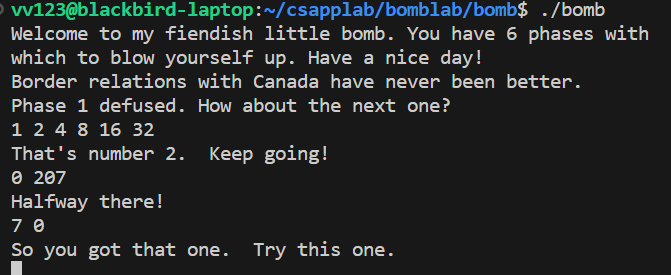
如果继续分析这个递归程序,应该还有其他的可行解。这里就不继续探讨了。
Phase 5 映射加密
0000000000401062 <phase_5>:
401062: 53 push %rbx
401063: 48 83 ec 20 sub $0x20,%rsp
401067: 48 89 fb mov %rdi,%rbx
40106a: 64 48 8b 04 25 28 00 mov %fs:0x28,%rax #金丝雀值
401071: 00 00 #nop
401073: 48 89 44 24 18 mov %rax,0x18(%rsp)
401078: 31 c0 xor %eax,%eax
这里mov %fs:0x28,%rax xor %eax,%eax 让人感觉很陌生。
它应该是出现在3.10.4节的栈破坏检测机制。作者对于该部分编译时未开启“-fno-stack-protector”选项。
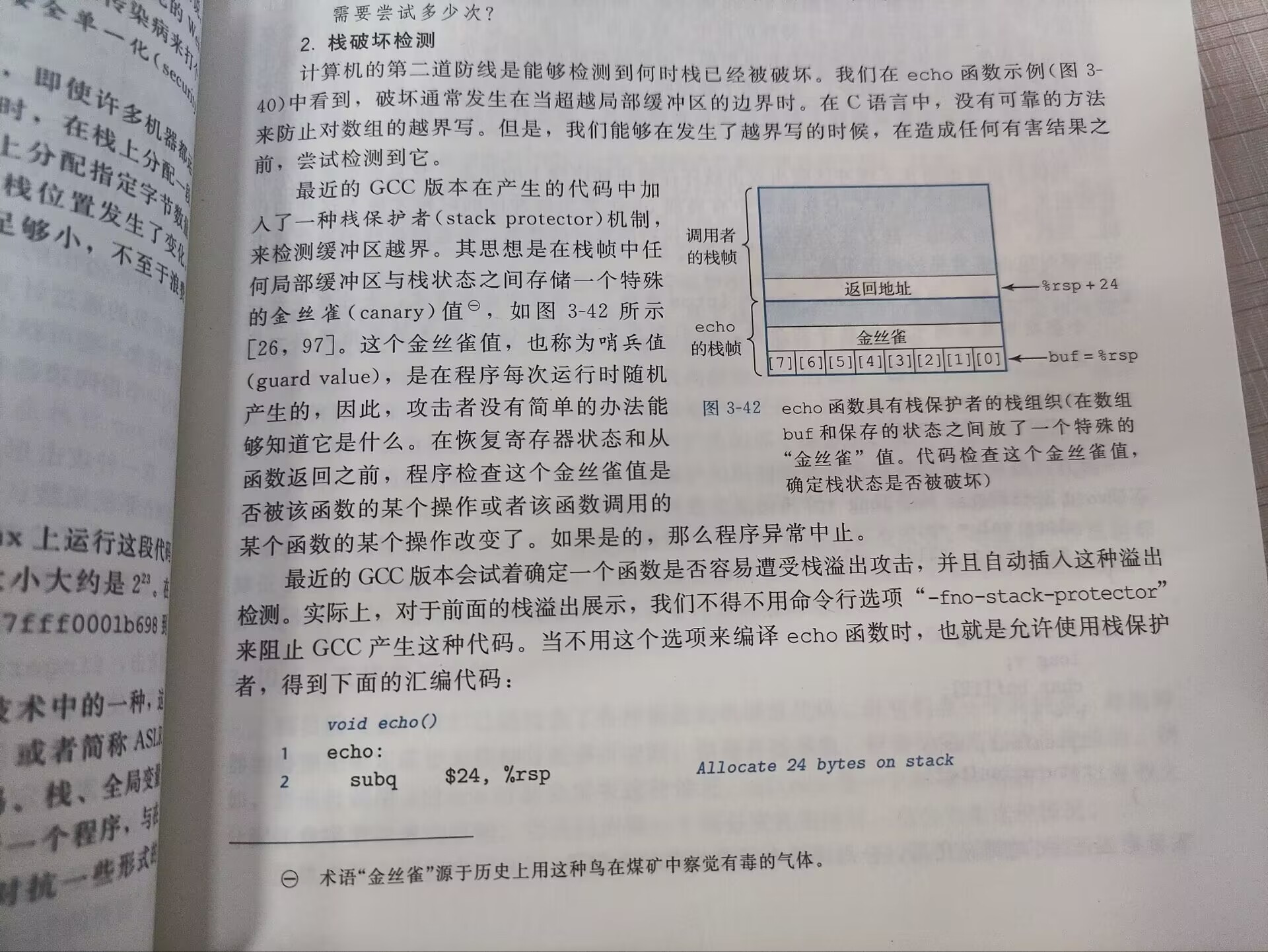
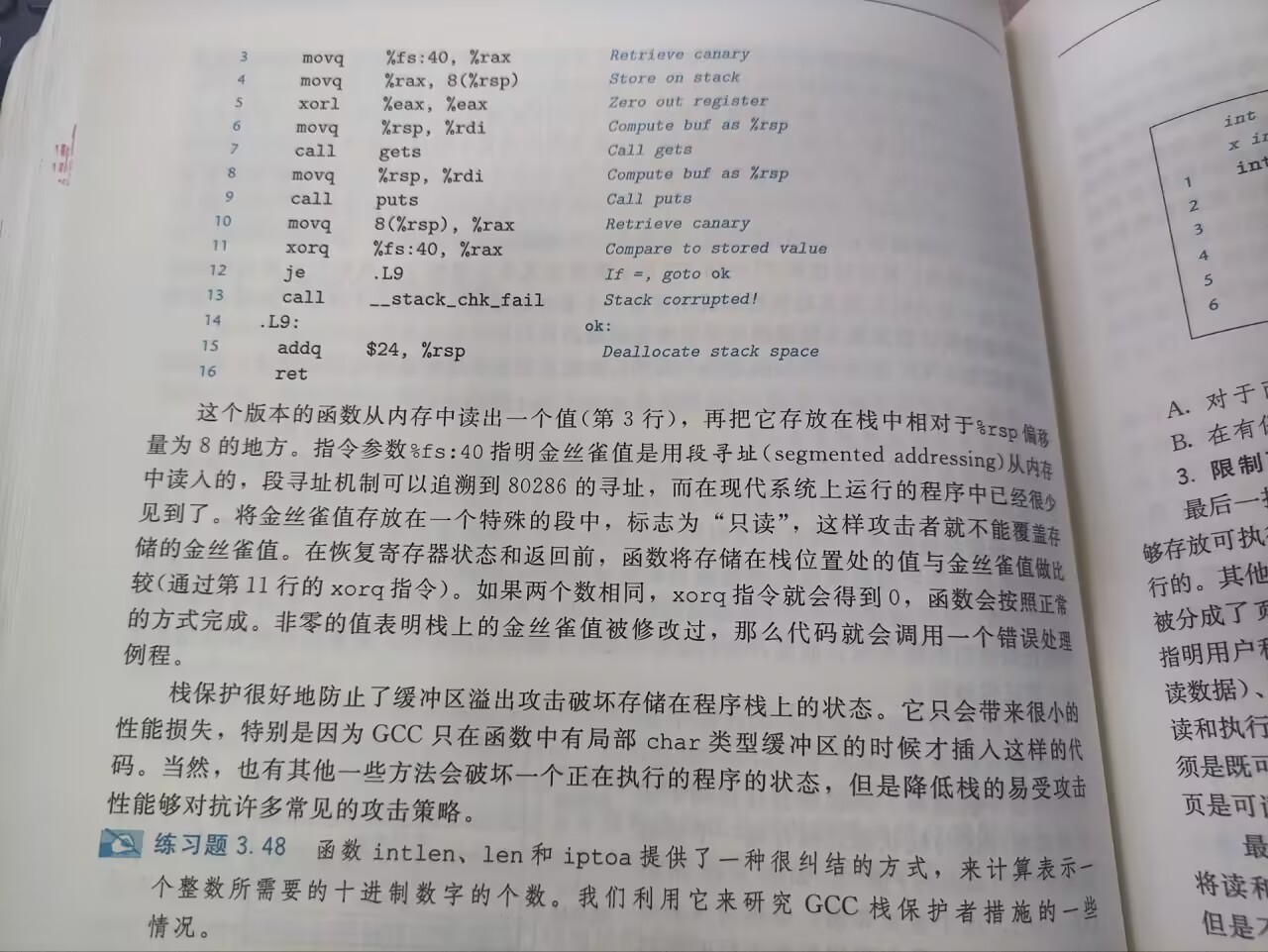
在这里出现,应该是防止学生用栈溢出攻击的手段解决这个题,其实不太需要管(
从程序的内容看,与phase1一样调用了strings_not_equal。
但是直接输入0x40245e处的字符串"flyers",就bomb了。需要进一步的分析。
40107a: e8 9c 02 00 00 callq 40131b <string_length>
40107f: 83 f8 06 cmp $0x6,%eax #如果输入字符串长度不为6,explode
401082: 74 4e je 4010d2 <phase_5+0x70>
401084: e8 b1 03 00 00 callq 40143a <explode_bomb>
401089: eb 47 jmp 4010d2 <phase_5+0x70>
#否则%eax置零后,跳到此处(记为int i = 0)
#下面是一个循环块
40108b: 0f b6 0c 03 movzbl (%rbx,%rax,1),%ecx #将(%rbx+i)处内容加载到%ecx
40108f: 88 0c 24 mov %cl,(%rsp) #%cl是%ecx的低8位,将其存储到(%rsp)处
401092: 48 8b 14 24 mov (%rsp),%rdx#再加载到%rdx
401096: 83 e2 0f and $0xf,%edx #然后与0xf按位与,即保留低4位,设结果为x
401099: 0f b6 92 b0 24 40 00 movzbl 0x4024b0(%rdx),%edx#(0x4024b0+x)处内容加载到%edx
4010a0: 88 54 04 10 mov %dl,0x10(%rsp,%rax,1)#将该字符存储到%rsp+10+i处
4010a4: 48 83 c0 01 add $0x1,%rax # i++;
4010a8: 48 83 f8 06 cmp $0x6,%rax # i<6;
4010ac: 75 dd jne 40108b <phase_5+0x29>
4010ae: c6 44 24 16 00 movb $0x0,0x16(%rsp) #在六个字母后添加'\0'
4010b3: be 5e 24 40 00 mov $0x40245e,%esi #目标字符串的地址作为参数2
4010b8: 48 8d 7c 24 10 lea 0x10(%rsp),%rdi #经过处理后的输入字符串地址作为参数1
4010bd: e8 76 02 00 00 callq 401338 <strings_not_equal> #调用字符串比较函数
4010c2: 85 c0 test %eax,%eax
4010c4: 74 13 je 4010d9 <phase_5+0x77> #返回0时,结束,否则bomb
4010c6: e8 6f 03 00 00 callq 40143a <explode_bomb>
4010cb: 0f 1f 44 00 00 nopl 0x0(%rax,%rax,1)
4010d0: eb 07 jmp 4010d9 <phase_5+0x77>
4010d2: b8 00 00 00 00 mov $0x0,%eax #here
4010d7: eb b2 jmp 40108b <phase_5+0x29>
4010d9: 48 8b 44 24 18 mov 0x18(%rsp),%rax
4010de: 64 48 33 04 25 28 00 xor %fs:0x28,%rax #栈破坏检测机制
4010e5: 00 00
4010e7: 74 05 je 4010ee <phase_5+0x8c>
4010e9: e8 42 fa ff ff callq 400b30 <__stack_chk_fail@plt>
4010ee: 48 83 c4 20 add $0x20,%rsp
4010f2: 5b pop %rbx
4010f3: c3 retq
通过上面的分析,我们发现,该程序对输入的字符串进行了一层映射,取输入字符的ascii码低4位作为偏移值x,取(0x4024b0+x)的内容放回原处。最后与0x40245e处的字符串进行比较。
用gdb查看0x4024b0、0x40245e两个位置的字符串。

flyers六个字母对应的x分别为9、15、14、5、6、7。
查表得'a'的ascii为01100001,输入第9、15、14、5、6、7个小写字母,即可满足要求。
因此一个可行的答案为ionuvw。

Phase 6 链表重排
phase_6很长,很复杂。根据jmp指令,将其划分为若干个循环块进行分析。
00000000004010f4 <phase_6>:
4010f4: 41 56 push %r14
4010f6: 41 55 push %r13
4010f8: 41 54 push %r12
4010fa: 55 push %rbp
4010fb: 53 push %rbx
4010fc: 48 83 ec 50 sub $0x50,%rsp
401100: 49 89 e5 mov %rsp,%r13
401103: 48 89 e6 mov %rsp,%rsi
401106: e8 51 03 00 00 callq 40145c <read_six_numbers>
#上面这一段执行后,读入6个整数,%rsp,%r13和%rsi指向第一个整数。
#L1
40110b: 49 89 e6 mov %rsp,%r14
40110e: 41 bc 00 00 00 00 mov $0x0,%r12d
401114: 4c 89 ed mov %r13,%rbp
401117: 41 8b 45 00 mov 0x0(%r13),%eax
40111b: 83 e8 01 sub $0x1,%eax #要求(%eax-1)<=5
40111e: 83 f8 05 cmp $0x5,%eax #也就是要求r13指向的整数不大于6
#后知后觉,这里还隐含了一个条件,r13指向的整数的整数必须大于0,即1<=(r13)<=6
#因为cmp是无符号数比较,如果r13=0,则减1后溢出,导致eax>5
401121: 76 05 jbe 401128 <phase_6+0x34>
401123: e8 12 03 00 00 callq 40143a <explode_bomb>
#下面是一个L1内部的小循环
#ebx从r12d到5,即检查后面的每个数,是否与%rbp相等
#即要求输入的6个数两两不同
401128: 41 83 c4 01 add $0x1,%r12d
40112c: 41 83 fc 06 cmp $0x6,%r12d
401130: 74 21 je 401153 <phase_6+0x5f>
401132: 44 89 e3 mov %r12d,%ebx
401135: 48 63 c3 movslq %ebx,%rax
401138: 8b 04 84 mov (%rsp,%rax,4),%eax
40113b: 39 45 00 cmp %eax,0x0(%rbp)
40113e: 75 05 jne 401145 <phase_6+0x51>
401140: e8 f5 02 00 00 callq 40143a <explode_bomb>
401145: 83 c3 01 add $0x1,%ebx
401148: 83 fb 05 cmp $0x5,%ebx
40114b: 7e e8 jle 401135 <phase_6+0x41>
40114d: 49 83 c5 04 add $0x4,%r13 #r13从第一个int开始,依次遍历6个int
401151: eb c1 jmp 401114 <phase_6+0x20> #goto L1
#总结:由L1知,输入的6个数是1~6的一个排列
#L2
401153: 48 8d 74 24 18 lea 0x18(%rsp),%rsi
401158: 4c 89 f0 mov %r14,%rax
40115b: b9 07 00 00 00 mov $0x7,%ecx
401160: 89 ca mov %ecx,%edx
401162: 2b 10 sub (%rax),%edx
401164: 89 10 mov %edx,(%rax)
401166: 48 83 c0 04 add $0x4,%rax
40116a: 48 39 f0 cmp %rsi,%rax
40116d: 75 f1 jne 401160 <phase_6+0x6c> #goto L2
#L2循环非常简单,依次把六个数从x变成7-x。显然仍是一个1~6的排列。
40116f: be 00 00 00 00 mov $0x0,%esi
401174: eb 21 jmp 401197 <phase_6+0xa3>
#L3
401176: 48 8b 52 08 mov 0x8(%rdx),%rdx #取结构体第三个整数,即*next
40117a: 83 c0 01 add $0x1,%eax
40117d: 39 c8 cmp %ecx,%eax
40117f: 75 f5 jne 401176 <phase_6+0x82>
#小循环执行%ecx-1次,即%rdx从第一个结点开始进行这么多次取next操作,然后跳到401188
#即:输入数为x时,取内存中的nodex的地址。401183特判了node1
401181: eb 05 jmp 401188 <phase_6+0x94>
401183: ba d0 32 60 00 mov $0x6032d0,%edx #当输入数为1时,取node1的地址
#否则,将nodex的地址,存到%rsp+(2*%rsi)+20处
401188: 48 89 54 74 20 mov %rdx,0x20(%rsp,%rsi,2)
40118d: 48 83 c6 04 add $0x4,%rsi #0x4*6=0x18
401191: 48 83 fe 18 cmp $0x18,%rsi #处理完6个数后,break
401195: 74 14 je 4011ab <phase_6+0xb7>
#从这里开始
401197: 8b 0c 34 mov (%rsp,%rsi,1),%ecx #%ecx = %rsp + %rsi
40119a: 83 f9 01 cmp $0x1,%ecx #依次取出每个数
40119d: 7e e4 jle 401183 <phase_6+0x8f> #如果当前数是1,跳到401183
40119f: b8 01 00 00 00 mov $0x1,%eax #否则跳到401176
4011a4: ba d0 32 60 00 mov $0x6032d0,%edx
4011a9: eb cb jmp 401176 <phase_6+0x82># goto L3
L3出现了一个内存地址0x6032d0,用gdb查看该处的值

可以发现,这里有6个结点。每个结点中,第二个整数是1~6,而第三个整数显然是指向另一个结点的指针。第一个整数应该是结点的另一个值属性。第四个位置应该是用于内存对齐。
可以认为,它是这样的一个结构体
//int a[]; 假设这是我们输入的
struct node {
int value;
int id; //1~6
node* next;
} b[];
这个链表是在内存中固定的,并不是我们输入的6个整数。
根据上面的分析,写出L3对应的C代码。
for (int i = 1; i <= 6; i++) {
node *x = &b[1];
for (int j = 1; j <= a[i] - 1; j++) {
x = x->next;
}
*(&a[i] + 20 + (i - 1) * 8) = x;
}
由于一开始链表b在内存中恰好是顺序排列的,因此处理完之后(%rsp + 20)开始的六个8字节变量分别是b[a[1]]~b[a[6]]的地址。
#b_addr[] a[1] a[2] a[3] a[4] a[5] a[6]
#(%rsp +) 20 28 30 38 40 48
4011ab: 48 8b 5c 24 20 mov 0x20(%rsp),%rbx #%rbx = &b_addr[a[1]]
4011b0: 48 8d 44 24 28 lea 0x28(%rsp),%rax #%rax = &b_addr[a[2]]
4011b5: 48 8d 74 24 50 lea 0x50(%rsp),%rsi #%rsi = &b_addr[a[6]] + 8
4011ba: 48 89 d9 mov %rbx,%rcx #%rcx = &b_addr[a[1]]
#L4
4011bd: 48 8b 10 mov (%rax),%rdx #等价mov (%rax),0x8(%rcx)
4011c0: 48 89 51 08 mov %rdx,0x8(%rcx) #0x8是next指针在结构体中的偏移
4011c4: 48 83 c0 08 add $0x8,%rax
4011c8: 48 39 f0 cmp %rsi,%rax
4011cb: 74 05 je 4011d2 <phase_6+0xde> #break
4011cd: 48 89 d1 mov %rdx,%rcx
4011d0: eb eb jmp 4011bd <phase_6+0xc9> #goto L4
4011d2: 48 c7 42 08 00 00 00 movq $0x0,0x8(%rdx) #最后一个数指向0
4011d9: 00
L4的等价代码为:
for (int i = 1, j = 2; j <= 6; i++, j++) {
b[a[i]].next = &b[a[j]];
}
b[a[6]].next = 0;
也就是说,我们将内存中的链表b的指向关系按照修改为b[a[1]]->b[a[2]]->b[a[3]]->b[a[4]]->b[a[5]]->b[a[6]]->0。
终于到了最后一部分:
4011da: bd 05 00 00 00 mov $0x5,%ebp
#注意L4部分没有修改%rbx,仍指向b[a[i]]
#L5
4011df: 48 8b 43 08 mov 0x8(%rbx),%rax
4011e3: 8b 00 mov (%rax),%eax
4011e5: 39 03 cmp %eax,(%rbx)
#比较rbx->value和rbx->next->value
#如果rbx->value < rbx->next->value, explode
4011e7: 7d 05 jge 4011ee <phase_6+0xfa>
4011e9: e8 4c 02 00 00 callq 40143a <explode_bomb>
4011ee: 48 8b 5b 08 mov 0x8(%rbx),%rbx #rbx = rbx->next
4011f2: 83 ed 01 sub $0x1,%ebp #循环无条件执行5次
4011f5: 75 e8 jne 4011df <phase_6+0xeb> #goto L5
4011f7: 48 83 c4 50 add $0x50,%rsp
4011fb: 5b pop %rbx
4011fc: 5d pop %rbp
4011fd: 41 5c pop %r12
4011ff: 41 5d pop %r13
401201: 41 5e pop %r14
401203: c3 retq
L5的功能是检测b[a[1]]->b[a[2]]->b[a[3]]->b[a[4]]->b[a[5]]->b[a[6]]的value是否满足降序

按照value降序连接,则应为b[3]->b[4]->b[5]->b[6]->b[1]->b[2]
因此a[1]~a[6] 为3 4 5 6 1 2
又因为L2进行a[x] = 7 - a[x]的操作,因此原来的a[x]应为 4 3 2 1 6 5
至此,6个任务全部完成。

其实还有一个隐藏关卡,有空再写((
总结
断断续续花了大概一个星期吧,意犹未尽。感觉就是csapp的lab远远要比看书重要。
设计得非常精彩,循序渐进又有一定挑战性,能让人学到东西。
相比某学院数电实验从0开始手写system verilog和ARM,高到不知道哪里去了。




 浙公网安备 33010602011771号
浙公网安备 33010602011771号